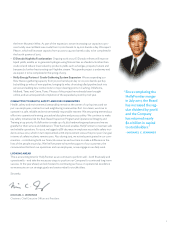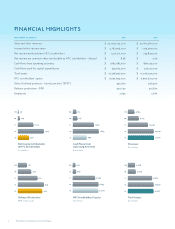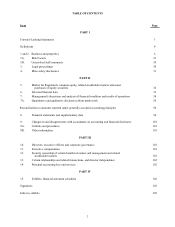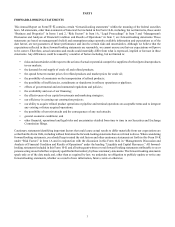HollyFrontier 2013 Annual Report Download - page 17
Download and view the complete annual report
Please find page 17 of the 2013 HollyFrontier annual report below. You can navigate through the pages in the report by either clicking on the pages listed below, or by using the keyword search tool below to find specific information within the annual report.
9
We have several significant customers, of which one accounted for more than 10% of our business in 2013. For the year ended
December 31, 2013, Sinclair accounted for $2,134.3 million, or 11%, of our revenues. Our principal customers for gasoline include
other refiners, convenience store chains, independent marketers and retailers. Diesel fuel is sold to other refiners, truck stop chains,
wholesalers and railroads. Jet fuel is sold for commercial airline use. Specialty lubricant products are sold in both commercial and
specialty markets. LPG's are sold to LPG wholesalers and LPG retailers. We produce and purchase asphalt products that are sold
to governmental entities, paving contractors or manufacturers. Asphalt is also blended into fuel oil and is either sold locally or is
shipped to the Gulf Coast. See Note 22 “Significant Customers” in the Notes to Consolidated Financial Statements for additional
information on our significant customers.
Mid-Continent Region (El Dorado and Tulsa Refineries)
Facilities
The El Dorado Refinery is a high-complexity coking refinery with a 135,000 barrels per stream day processing capacity and the
ability to process significant volumes of heavy and sour crudes. The Tulsa West and East refinery facilities are both located in
Tulsa, Oklahoma. In 2011, we integrated certain refining processes of the Tulsa Refineries which effectively provides us with a
highly complex refining operation having a combined crude processing rate of approximately 125,000 barrels per stream day. For
2013, gasoline, diesel fuel, jet fuel and specialty lubricants (excluding volumes purchased for resale) represented 47%, 31%, 8%
and 4%, respectively, of our Mid-Continent sales volumes.
The following table sets forth information about our Mid-Continent region operations, including non-GAAP performance measures.
Years Ended December 31,
2013 2012 2011 (10)
Mid-Continent Region (El Dorado and Tulsa Refineries)
Crude charge (BPD) (1) 234,930 248,360 183,070
Refinery throughput (BPD) (2) 257,030 269,760 194,310
Refinery production (BPD) (3) 251,470 263,310 188,760
Sales of produced refined products (BPD) 247,030 254,350 188,020
Sales of refined products (BPD) (4) 269,790 258,020 190,340
Refinery utilization (5) 90.4% 95.5% 94.8%
Average per produced barrel (6)
Net sales $ 115.63 $ 119.19 $ 119.51
Cost of products (7) 99.35 95.77 99.92
Refinery gross margin 16.28 23.42 19.59
Refinery operating expenses (8) 5.50 4.83 5.04
Net operating margin $ 10.78 $ 18.59 $ 14.55
Refinery operating expenses per throughput barrel (9) $ 5.29 $ 4.55 $ 4.88
Feedstocks:
Sweet crude oil 69% 70% 82%
Sour crude oil 6% 8% 4%
Heavy sour crude oil 16% 14% 8%
Other feedstocks and blends 9% 8% 6%
Total 100% 100% 100%
Footnote references are provided under our Consolidated Refinery Operating Data table on page 8.
The El Dorado Refinery is located on 1,100 acres south of El Dorado, Kansas and is a fully integrated refinery. The principal
processing units at the El Dorado Refinery consist of crude and vacuum distillation; hydrodesulfurization of naphtha, kerosene,
diesel, and gas oil streams; isomerization; catalytic reforming; aromatics recovery; catalytic cracking; alkylation; delayed coking;
hydrogen production; and sulfur recovery. Refining operations began at the site in 1917 and the operating units now present include
both newly constructed units and older units that have been upgraded over the years. Supporting infrastructure includes maintenance
shops, warehouses, office buildings, a laboratory, utility facilities, and a wastewater plant (“Supporting Infrastructure”) and logistics
assets owned by HEP, which includes approximately 3.6 million barrels of tankage, a truck sales terminal, and a propane terminal.
The facility typically processes approximately 135,000 BPSD of crude oil with the capability to handle a significant volume of
heavy sour crudes.
Table of Content
























